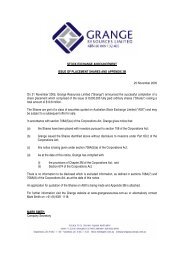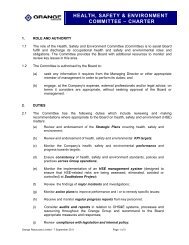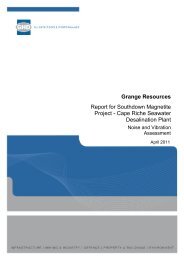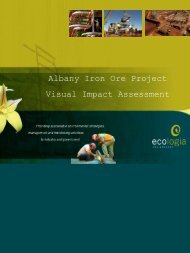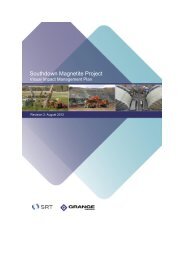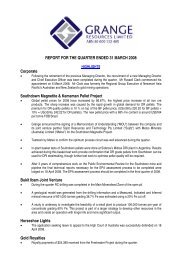Appendix A - Flora and Fauna Survey - Grange Resources
Appendix A - Flora and Fauna Survey - Grange Resources
Appendix A - Flora and Fauna Survey - Grange Resources
You also want an ePaper? Increase the reach of your titles
YUMPU automatically turns print PDFs into web optimized ePapers that Google loves.
2.2.2 Botanical <strong>Survey</strong> Limitations<br />
Complete flora <strong>and</strong> vegetation surveys can require multiple surveys, at different times of year, <strong>and</strong> over a<br />
period of a number of years, to enable observation of all species present. Some flora species, such as<br />
annuals, are only available for collection at certain times of the year, <strong>and</strong> others are only identifiable at<br />
certain times (such as when they are flowering). Additionally, climatic <strong>and</strong> stochastic events (such as<br />
fire) may affect the presence of plant species. As mentioned previously, rainfall in the months preceding<br />
the survey has shown distinct differences to the long term averages. The Cape Riche/Wellstead area<br />
received substantially less rain in the September–October period <strong>and</strong> showed large fluctuation from the<br />
average prior to this. This variability in rainfall may have affected the health of individual plants making<br />
species that have a very low abundance in the area more difficult to locate. The other factors identified<br />
above may also make species with a very low abundance in the area more difficult to locate.<br />
<strong>Flora</strong> composition changes over time, with flora species having specific growing periods, especially<br />
annuals <strong>and</strong> ephemerals (some plants lasting for a markedly brief time, some only a day or two).<br />
Therefore, the results of future botanical surveys in this location may differ from the results of this survey.<br />
The Study Area covers approximately 86 ha. Sampling was conducted using quadrats, relevès <strong>and</strong><br />
targeted searches by intensively traversing areas likely to contain conservation significant species. The<br />
majority of species would have been identified using these techniques; however, it is possible that<br />
species with a low abundance, seasonal presence, or with a very restricted local range were not<br />
observed.<br />
2.3 <strong>Fauna</strong> Field Investigation<br />
The Level 1 fauna assessment was conducted in accordance with EPA Guidance Statement No. 56<br />
Assessment of Environmental Factors for Terrestrial <strong>Fauna</strong> <strong>Survey</strong>s for Environmental Impact<br />
Assessment in Western Australia (EPA, 2004b). The assessment included a desktop investigation <strong>and</strong><br />
opportunistic fauna field survey (vertebrate only) <strong>and</strong> a habitat assessment, undertaken in conjunction<br />
with the vegetation <strong>and</strong> flora survey. The field assessment involved visual <strong>and</strong> aural surveys for any<br />
fauna species utilising the Study Area in addition to searches of the Study Area for any fauna signs, such<br />
as tracks, scats, bones, diggings <strong>and</strong> feeding signs. The fauna assessment did not involve any fauna<br />
trapping.<br />
In addition, habitat types of the Study Area were identified. The habitat types present in the Study Area<br />
reflect both the l<strong>and</strong>forms present <strong>and</strong> vegetation communities.<br />
2.3.1 Limitations<br />
The fauna assessment undertaken was a reconnaissance survey only <strong>and</strong> thus only sampled those<br />
species that can be easily seen, heard or have distinctive signs, such as tracks, scats, diggings etc.<br />
Many cryptic <strong>and</strong> nocturnal species would not have been identified during a reconnaissance survey.<br />
Extensive detailed fauna surveys, involving trapping surveys, are required to obtain a more<br />
comprehensive list of fauna species that may utilise the site.<br />
The fauna assessment was aimed at identifying habitat types within the Study Area. In addition,<br />
terrestrial vertebrate fauna utilising the Study Area were identified; no sampling for invertebrates or<br />
aquatic species occurred. The information available on the identification, distribution <strong>and</strong> conservation<br />
status of invertebrates is generally less extensive than that of vertebrate species.<br />
4



